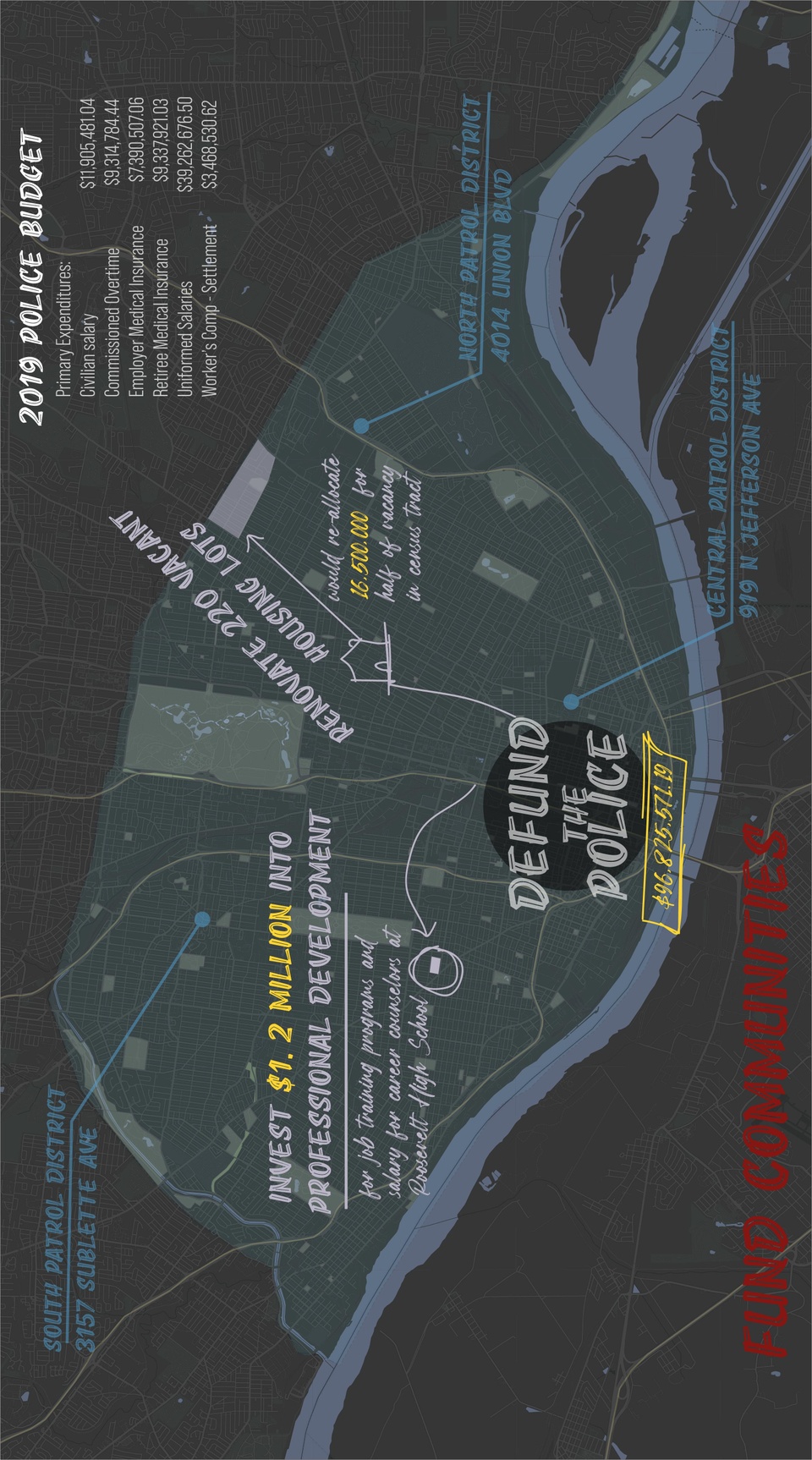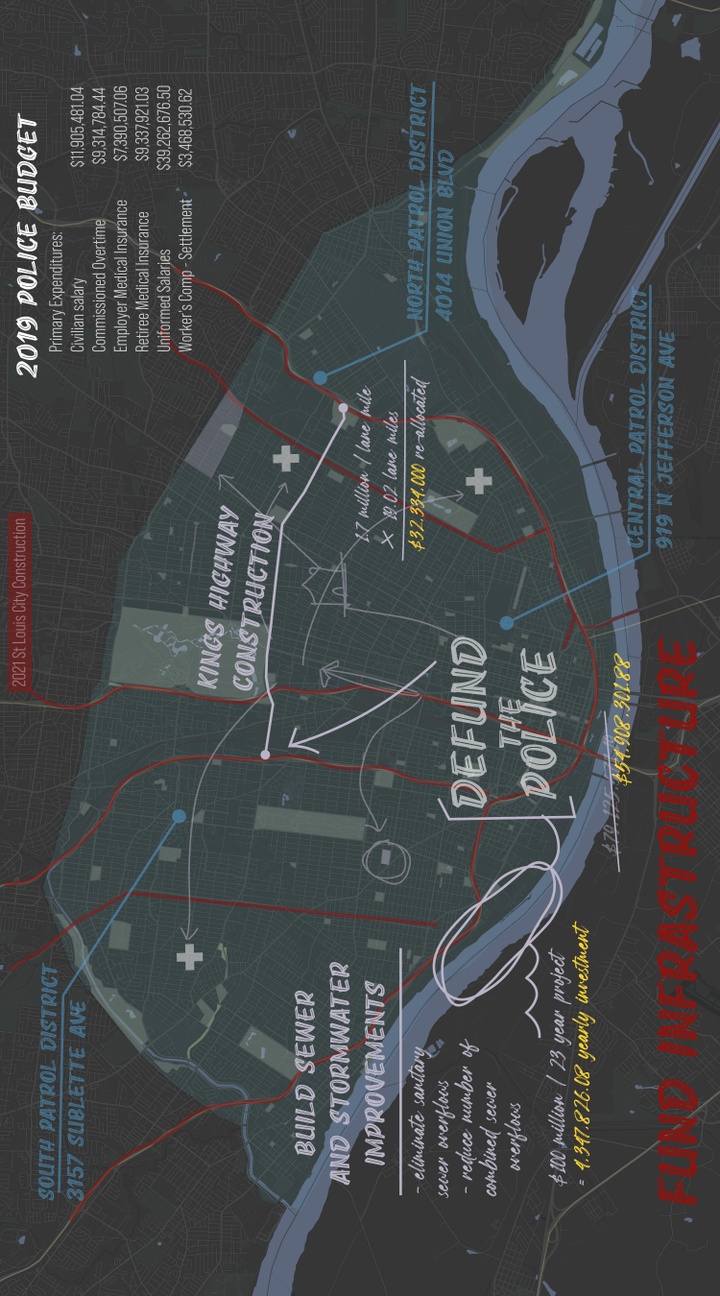Alternative Atlas
2021-07-19 • Liz Kramer

Map image from Alternative Atlas
Spring 2021 architecture seminar led by associate professor Linda C. Samuels, in coordination with Geoff Ward and Walter Johnson.
Exposing hidden structures, contestations, and institutionalized power relationships in cities like St. Louis requires many perspectives and experiences. The experimental, interdisciplinary seminar Alternative Atlas amplified a range of these views — from local guests to concurrent and collaborative instructors — to inform students’ learning and the creation of a set of maps that document these structures.
The Alternative Atlas seminar umbrella brought together two courses at Washington University and one at Harvard University:
- Alternative Atlas: St. Louis, an interdisciplinary seminar led by Linda Samuels, associate professor of urban design in the Sam Fox School of Design & Visual Arts at WashU.
- Histories of Racial Violence, Legacies & Reckonings, a graduate seminar and practicum in African and African-American Studies and sociology led by Geoff Ward, professor of African and African-American studies in Arts & Sciences at WashU.
- History of St. Louis, an undergraduate history seminar led by Walter Johnson, Winthrop Professor of History and African and African American studies at Harvard University and author of the recent major work, The Broken Heart of America: St. Louis and the Violent History of the United States.
Bringing these three courses together also facilitated overlaps and conversations across disciplines, including architecture, communication design, history, African and African American studies, sociology, planning, and anthropology. Samuels’ section included architecture undergraduate and graduate students as well as anthropology PhD students.
“Intellectually, it was a mind-opening awakening to engage these ideas of race, justice, history, and memory from experts in the field,” Samuels said. “I hope the collaborating faculty felt the same about what I brought regarding design, planning, space, and spatial justice. This broad range of exposures to deep content was extremely valuable.”
The thirteen students in the course moved through three phases of learning: representing the city, mapping the palimpsest, and building the atlas. In addition to being introduced to the often unseen biases and agendas of maps and the mapping process, they began the course learning about the history of St. Louis and its legacies of racial capitalism and erasure. Readings, lectures, and discussions explored how documentation and maps both reveal and hide the histories of exploitation and domination in the city. Later in the semester, community partners shared ongoing work supporting justice efforts and memory preservation and celebration in the region. These collective conversations also exposed both the challenges and potential of mixing divergent disciplinary perspectives, with the process further complicated by the need to work remotely, particularly in terms of unifying multiple skill sets.
“We made excellent use of the user-friendly, virtual pinup platform Figma, which we used to document and organize our brainstorming and connect images, theories, and data,” Samuels said. “Our Figma board was an amazing, messy, stream-of-consciousness take on our process and the hard work of identifying broad yet critical categories of shared interest.”
Building on their learning about history and disciplinary approaches, the group then began to locate key moments, people, places, and relationships. This process of mapping focused on themes that are at the nexus of race, space, and environment, but might typically be hidden from view in more traditional maps. These themes included racial capitalism, empire, enslavement, and apartheid; contested spaces of infrastructure and publicness; and African American cultural and intellectual history.
For students, exploring these themes and learning about the context of St. Louis was challenging, particularly in the midst of the COVID-19 pandemic.
“As a new St. Louis resident, I first needed to dive into the historical context and current socioeconomic climate of St. Louis,” graduate architecture student Emily Sanders said. “I educated myself about the untold stories and counter-narratives of St. Louis that we wanted to expose as a class. I then individually searched for data or resources to support these ideas. For the final representation, I envisioned juxtaposition as a representation style to reflect the traditional and alternatives narratives in conflict. By pairing quantitative data with more abstract opportunities for the city’s future growth or overlaying hand sketches on top of hard-lined maps, the contrasting style strengthened the alternative atlas format.”
From this process of mapping, themes emerged for the Atlas itself, a work in progress that is ultimately meant to be accessible and usable by members of the community and those doing related work. Currently, the Atlas is organized into loose themes that span past, present, and future, including “A Wounded City,” “Toxicity and Growth,” “Remembering and Unremembering,” and “Survival as Resistance.”
Students worked in teams, bringing together their different skills and experiences.
“Having a team with a variety of backgrounds can be difficult when tackling a software-dependent deliverable,” Sanders said. “However, my project group capitalized on each person’s strengths as some were more familiar with ArcGIS, and others—myself included—were more comfortable with the creative process and physical production through Adobe software. The collaboration with my peers expanded my knowledge of St. Louis, revealed new personal strengths to use in team settings, and ultimately created a unique product that is meaningful to the local community and accessible to a broad public audience.”
Students also strengthened important collaborative skills through the interdisciplinary aspect of the courses. “In my view, walking out of the course, I’ve come to understand interdisciplinary research and learning as fundamentally an exercise in compromise and communication,” said Rebecca Ann Dudley, a PhD student in Anthropology. “Compromise, in that we come into conversation with our own disciplinary preconceptions, vocabularies, and worldviews that are immediately confronted by the theories, words, and missions of others. It demands you to rethink scholarship as something that exists in the world, and to ask: what does it do? And, what are we doing together? What are the moral implications of what we’re doing together? Interdisciplinary work demands vulnerability and humility in recognizing that one discipline is insufficient, and that you must rely on others, and trust in others, to build something larger than you alone can accomplish.”
The next steps for the Atlas and the collaboration between Samuels, Ward, and Johnson are a work in progress.
“We’re still sorting out these complex topics,” Samuels said. “The hope is to come to some closure with the research and mapping completed in the course and then use that as a springboard for future work. We see this as the beginning of a much bigger, collective effort to grapple both with the complexities of such deeply contested, culturally rich—yet under-represented—territory and the promise of cross-disciplinary work among students and faculty.”
This course was funded in part by the Center for the Study of Race, Ethnicity, & Equity’s Rotating Graduate Studio Program. Support was also provided through the CityStudioSTL Faculty Course Grant.









